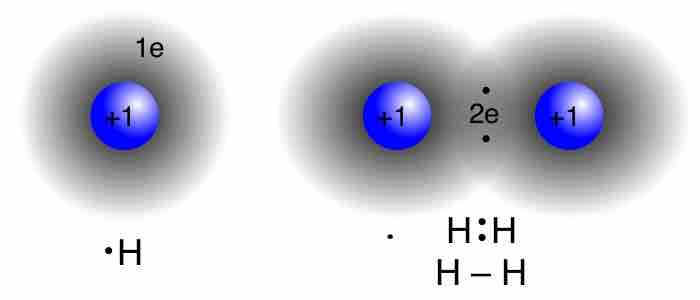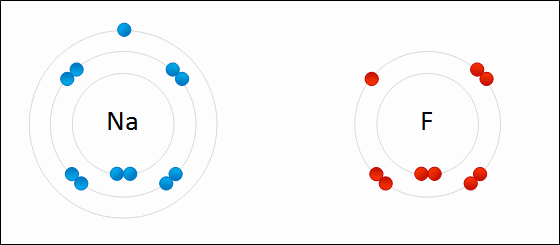Two Classes of Compounds
Compounds are defined as substances containing two or more different chemical elements. They have distinct chemical structures characterized by a fixed ratio of atoms held together by chemical bonds. Here, we discuss two classes of compounds based on the bond type that holds the atoms together: ionic and covalent.
Covalent Compounds
Covalent bonds are characterized by the sharing of electrons between two or more atoms. These bonds mostly occur between nonmetals or between two of the same (or similar) elements.Two atoms with similar electronegativity will not exchange an electron from their outermost shell; the atoms instead share electrons so that their valence electron shell is filled.
Examples of compounds that contain only covalent bonds are methane (CH4), carbon monoxide (CO), and iodine monobromide (IBr).

Covalent bonding between hydrogen atoms
Since each hydrogen atom has one electron, they are able to fill their outermost shells by sharing a pair of electrons through a covalent bond.
Ionic Compounds
Ionic bonding occurs when there is a large difference in electronegativity between two atoms. This large difference leads to the loss of an electron from the less electronegative atom and the gain of that electron by the more electronegative atom, resulting in two ions. These oppositely charged ions feel an attraction to each other, and this electrostatic attraction constitutes an ionic bond.
Ionic bonding occurs between a nonmetal, which acts as an electron acceptor, and a metal, which acts as an electron donor. Metals have few valence electrons, whereas nonmetals have closer to eight valence electrons; to easily satisfy the octet rule, the nonmetal will accept an electron donated by the metal. More than one electron can be donated and received in an ionic bond.
Some examples of compounds with ionic bonding include NaCl, KI, MgCl2.

Formation of sodium fluoride (NaF)
The transfer of an electron from a neutral sodium atom to a neutral fluorine atom creates two oppositely charge ions: Na+ and F-. Attraction of the oppositely charged ions is the ionic bond between Na and F.
Effect on Physical Properties
Covalent and ionic compounds can be differentiated easily because of their different physical properties based on the nature of their bonding. Here are some differences:
- At room temperature and normal atmospheric pressure, covalent compounds may exist as a solid, a liquid, or a gas, whereas ionic compounds exist only as solids.
- Although solid ionic compounds do not conduct electricity because there are no free mobile ions or electrons, ionic compounds dissolved in water make an electrically conductive solution. In contrast, covalent compounds do not exhibit any electrical conductivity, either in pure form or when dissolved in water.
- Ionic compounds exist in stable crystalline structures. Therefore, they have higher melting and boiling points compared to covalent compounds.